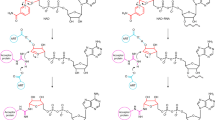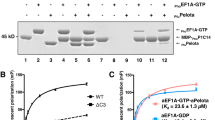Abstract
Archaebacteria have been defined as a ‘third primary kingdom’ of cells in addition to the urkaryotes and the eubacteria1. While the latter two correspond approximately to the conventional categories eukaryotes and prokaryotes respectively, the Archaebacteria have up to now comprised four groups of microorganisms: the methanogenic bacteria, the extremely halophilic bacteria and the two thermoacidophilic genera Sulfolobus and Thermoplasma. Based on ribosomal RNA sequence homologies and lipid composition, they apparently form a distinct group. Furthermore they possess or lack typical biochemical markers of both the eukaryotes and the prokaryotes, as well as having unique properties not found elsewhere2. Altogether, this indicates that they are not closer to either one of the classical categories. One clear-cut difference between prokaryotes and eukaryotes is the diphtheria toxin reaction, which catalyses the covalent binding of adenosine diphosphateribose (ADPR) to the eukaryotic peptide elongation factor EF2 in contrast to the homologous prokaryotic factor EF-G3,4. We report here that diphtheria toxin also catalyses the ADP-ribosylation of archaebacterial elongation factors. In this respect, these factors have to be assigned to the EF2 type; we suppose that the ADP-ribosylatable structure arising so early in evolution is of fundamental importance for the elongation process.
This is a preview of subscription content, access via your institution
Access options
Subscribe to this journal
Receive 51 print issues and online access
$199.00 per year
only $3.90 per issue
Buy this article
- Purchase on Springer Link
- Instant access to full article PDF
Prices may be subject to local taxes which are calculated during checkout
Similar content being viewed by others
References
Woese, C. R. & Fox, G. E. Proc. natn. Acad. Sci. U.S.A. 74, 5088–5090 (1977).
Woese, C. R., Magrum, L. J. & Fox, G. E. J. molec. Evol. 11, 245–252 (1978).
Collier, R. J. Bact. Rev. 39, 54–85 (1975).
Gill, D. M. & Pappenheimer, A. M. J. biol. Chem. 246, 1492–1495 (1971).
Laemmli, U. K. Nature 227, 680–685 (1970).
Drazin, R., Kandel, J. & Collier, R. J. J. biol. Chem. 246, 1504–1510 (1971).
Kaziro, Y., Inove-Yokosawa, N. & Kawakita, M. J. Biochem, 72, 853–863 (1972).
Tsugawa, A., Ohsumi, Y. & Kato, I. J. Bact. 104, 152–157 (1970).
Johnson, W. R., Kuchler, R. J. & Solotorovsky, M. J. Bact. 96, 1089–1098 (1968).
Richter, D. & Lipmann, F. Biochemistry 9, 5065–5070 (1970).
Bayley, S. T. & Griffith, E. Biochemistry 7, 2249–2256 (1968).
Kessel, M. & Klink, F. in Energetics and Structure of Halophilic Microorganisms (eds Caplan, S. R. & Ginzburg M.) 453 (Elsevier, Amsterdam, 1978).
Bodley, J. W., Van Ness, B. B., Brown, B. A. & Howard, J. B. Fedn Proc. 38, 2059 (1979).
Robinson, E. A., Henrikson, O. Z. Maxwell, E. S. J. biol. Chem. 249, 5088–5093 (1974).
Brown, B. & Bodley, J. W. FEBS Lett. 103, 253–255 (1979).
Hamel, E., Koka, M. & Nakamoto, T. J. biol. Chem. 247, 805–814 (1972).
Matheson, A. T., Yaguchi, M., Nazar, R. N., Visentin, L. P. & Willick, G. E. in Energetics and Structure of Halophilic Microorganisms (eds Caplan, S. R. & Ginzburg, M.) 481–501 (Elsevier, Amsterdam, 1978).
Author information
Authors and Affiliations
Rights and permissions
About this article
Cite this article
Kessel, M., Klink, F. Archaebacterial elongation factor is ADP-ribosylated by diphtheria toxin. Nature 287, 250–251 (1980). https://doi.org/10.1038/287250a0
Received:
Accepted:
Issue Date:
DOI: https://doi.org/10.1038/287250a0
This article is cited by
-
Chromosomal organization and nucleotide sequence of the genes for elongation factors EF-1α and EF-2 and ribosomal proteins S7 and S10 of the hyperthermophilic archaeum Desulfurococcus mobilis
Molecular and General Genetics MGG (1995)
-
Regeneration and functional incorporation of bacteriorhodopsin in membranes of fission yeast but not inE. coli
Journal of Protein Chemistry (1989)
Comments
By submitting a comment you agree to abide by our Terms and Community Guidelines. If you find something abusive or that does not comply with our terms or guidelines please flag it as inappropriate.



